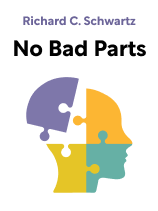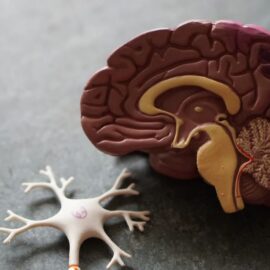

This article is an excerpt from the Shortform book guide to "No Bad Parts" by Richard C. Schwartz. Shortform has the world's best summaries and analyses of books you should be reading.
Like this article? Sign up for a free trial here.
What is Richard Schwartz’s No Bad Parts about? What is the key message to take away from the book?
In No Bad Parts, Richard Schwartz provides a broad overview of Internal Family Systems (IFS)—a therapeutic practice grounded in the idea that each of us is made up of a complex network of different “parts.” He outlines the theory behind its basic principles and how it can help people to live a more fulfilling life.
Below is a brief overview of No Bad Parts: Healing Trauma and Restoring Wholeness with the Internal Family Systems Model.
No Bad Parts: Healing Trauma and Restoring Wholeness with the Internal Family Systems Model
In No Bad Parts, Dr. Richard Schwartz introduces Internal Family Systems (IFS), an evidence-based model of psychotherapy that challenges the prevailing therapeutic assumption of the unitary mind. IFS suggests that instead of being only one person, we all hold multiple people within us—a core Self and multiple co-existing internal parts (or subpersonalities) that relate to each other in the same ways that members of a family might relate to one another. Just like a family, our internal system can be supportive and loving, or toxic and destructive. The goal of IFS is to help patients access their core Self in order to “heal” wounded internal parts and end negative patterns within the internal family system.
While anyone can benefit from IFS therapy, it can be particularly helpful for people working through traumatic experiences.
Schwartz, the creator of IFS, began his career working as a marriage and family therapist. He also taught at the University of Illinois at Chicago and worked at The Family Institute at Northwestern University. Early in his career, Schwartz was particularly interested in the Bowen family systems theory, which describes the family as an interconnected emotional system in which individuals are best understood within the context of their family relationships.
IFS grew out of Schwartz’s expertise in family systems. He began to develop the theory of IFS in the early 1980s after hearing numerous clients refer to “inner parts” of themselves. His clients described how these parts were in conflict with one another, wrestling with different needs, motivations, and desires, just as a family might. Schwartz began to wonder if the concept of family systems could be applied to an individual’s network of internal parts.
He published his seminal paper on “Internal Family Systems” in 1987. Since then, Schwartz has published multiple books on the subject, including Internal Family Systems Therapy (1997), You Are the One You’ve Been Waiting For (2008), and, most recently, No Bad Parts (2021). In 2000, Schwartz founded the Center for Self Leadership, which later became The IFS Institute, which offers ongoing professional training in the IFS approach. He is an associate clinical professor of psychiatry at Harvard Medical School.
Since Schwartz first developed IFS, the model has evolved from a tentative theory to an evidence-based therapeutic practice with recommended methodology and professional guidelines for working with clients. The IFS Institute offers ongoing professional training in the IFS approach. There are thousands of trained IFS therapists implementing the model worldwide, either as a therapeutic tool or their primary approach.
No Bad Parts is written for people who are curious about IFS and interested in exploring it as a therapeutic tool. However, while Schwartz offers multiple introductory exercises throughout the book, he cautions readers against digging too deeply into the process without the support and guidance of a trained IFS therapist or practitioner because IFS has the potential to uncover traumatic experiences.
In this guide, we’ll discuss the theoretical foundations of IFS, explain how it works and what it looks like in practice, expanding on Schwartz’s explanations with ideas and strategies offered by other IFS therapists when necessary. In addition, we’ll also introduce some of the criticism surrounding IFS as a therapeutic tool.
The Foundations of IFS
In order to understand IFS therapy, it’s important to first understand the two foundational concepts on which it’s built: multiplicity and systems thinking.
Multiplicity
In this section, we’ll introduce dominant cultural conceptions of the “self” before explaining Schwartz’s alternative model of “multiplicity.”
The pervasive theory of the self in psychology proposes the existence of one mind, referred to by the author as the “mono-mind,” from which all thoughts and feelings emanate. This theory suggests that everything we think, feel, imagine, and desire comes from a singular, unified self.
Schwartz argues that the “mono-mind” conception of self is not only false, but damaging. The problem with this paradigm, according to Schwartz, is that if we’re only one thing, then any shameful, violent, or otherwise socially unacceptable thought or emotion challenges our core identity. We then feel obligated to suppress or control those parts of who we are, resulting in feelings of self-hate, shame, and anxiety.
He proposes an alternative concept of self in which we all have a core Self and a “multiplicity” of parts inside of us, none of which are inherently bad, and all of which want what’s best for us. This concept of internal multiplicity flies in the face of longstanding cultural norms that frame the idea of multiple selves as a product of emotional damage or mental illness (for example, Dissociative Identity Disorder, formerly known as Multiple Personality Disorder). Schwartz explains that honoring, instead of pathologizing, our multiplicity allows us to see every part of who we are as deserving of attention and compassion.
Schwartz emphasizes that our internal parts aren’t metaphors or symbols but beings with their own complex thoughts, emotions, and motivations. If you haven’t explored this concept before, it can be hard to imagine. Imagine you’re debating whether to attend a party. You might notice that one part of you really wants to go–it says you’ll have fun and meet new people–while another part of you might caution you to stay home because you probably won’t know anyone and will feel out of place. These two internal monologues are different internal parts that have conflicting motivations: The first one wants to help you expand your horizons, while the second wants to protect you from rejection.
Systems Thinking
The concept of multiplicity is the first step in understanding the Internal Family Systems model. Next is the concept of systems thinking. In this section, we’ll briefly describe systems thinking as it relates to the family systems theory that inspired Schwartz to develop IFS.
Systems thinking is the idea that we can’t understand something by looking at its parts in isolation. Exploring the relationships and patterns within a system helps us to understand both the whole and the parts. Consider how an ecosystem works. We can better understand a species of flora or fauna by observing how it relates to and interacts with other species in the environment.
In psychotherapy, the Family Systems Theory uses systems thinking to understand the family as a whole unit. The theory argues that instead of diagnosing a child in isolation, therapists should work with a child within their family context—noticing how family members relate and interact, considering what roles different family members take on, and confronting unconscious values and beliefs. For example, in a family where the parents are often in conflict, a child may take on the role of the mediator, believing that they’re responsible for keeping the peace in the household.
IFS suggests that, just like in a family, our internal parts interact with each other in a similarly complex web of relationships, often taking on well-intentioned but unhealthy roles.
IFS Therapy in Practice
In this next section, we’ll explain the goals of IFS, define key terms, and dig into what IFS therapy looks like in practice. (This section is intended as a theoretical introduction to the model, but Schwartz cautions against trying IFS therapy without the support of a trained IFS therapist.)
The overarching goal of IFS is to heal our inner family system by healing the wounded parts of ourselves so that we can approach ourselves and the world with more compassion and curiosity.
Like the better-known Cognitive Behavior Therapy (CBT), IFS is a form of talk therapy. IFS-trained therapists use questions, suggestions, and active listening to guide clients through the process of getting to know their inner family system and healing their wounded parts.
Part 1: Getting to Know Your Internal Family System
Before trying to change anything about our internal family system, Schwartz recommends starting to develop awareness about our inner system, starting with the Self.
The Self
The Self is the leader of the internal family system—innately wise, compassionate, and patient. According to Schwartz, the Self doesn’t overpower or undermine our parts, but rather acts as a “caretaker” for them. Schwartz describes the Self as a healthy, loving parent-figure whose purpose is to guide and nurture the parts. Unlike the rest of the parts in our internal system, we can’t observe or speak to our Self because it is the “seat of consciousness” from which we experience our internal and external worlds.
When we notice ourselves feeling openhearted and curious, we’re practicing what Schwartz refers to as Self-leadership or Self energy. Consider the following example. It’s Sunday night. You’re tired and thinking about taking the morning off from work. One part of you tells you that you need to rest, while another part scolds you for slacking. You might feel guilty about wanting a morning off or worried about what your boss will say if you stay home. These feelings stem from parts. However, if you’re practicing Self-leadership, your Self would be curious about these seemingly conflicting desires and want to know more about the motivations behind them.
The Parts
The next step in getting to know your inner family system is getting to know your parts.
Each of our parts, or subpersonalities, is a piece of who we are. They have their own goals and motivations, even memories, and different levels of wisdom, maturity, and emotionality. They might take on different forms or be a younger version of ourselves.
All of our parts have good intentions for us, but parts can sometimes get trapped in roles that make them act in extreme, unproductive, or destructive ways. For example, someone who has experienced abuse as a child might have a part that’s trapped in that traumatized place, and a part who, out of a protective instinct, routinely sabotages intimate relationships for fear of getting hurt.
Like getting to know our Self, the first step in getting to know our parts is practicing greater self-awareness. When do certain emotions come up and why? For example, imagine you have dinner plans with a friend and they show up 40 minutes late. If part of you feels deeply angry at your friend, that angry part might be a defense mechanism to protect you from the deeper fear of being abandoned. Paying closer attention to your emotional landscape will help you get to know the parts in your inner family system.
While Schwartz emphasizes that all internal family systems are unique to the individual, our parts tend to organize themselves into one of two categories: vulnerable parts (called exiles) and protective parts.
Exiles
Schwartz refers to our vulnerable parts as exiles. Exiles are the youngest and most vulnerable versions of who we are, sometimes referred to as our “inner children.” They’re often the parts that have directly experienced some kind of trauma and then took on the burden of those emotions, leaving them trapped in the past.
While these inner children are often sweet, innocent, playful, and trusting, they’re also highly sensitive and prone to being hurt. Exiles are the parts of ourselves that we’re most likely to hide because we don’t want to experience their hurt or shame. For example, imagine you were yelled at for crying when you were a young child. This might create an exiled part of you that feels shame anytime you cry in front of other people.
Protectors
Meanwhile, our protective parts are the parts of ourselves that take on the role of defending our exiles from future hurt. To continue the above example—if there was an exile that felt shame for crying publicly, there might be a protector who shows up when the exile is feeling especially sad who tells the exile to “suck it up.” Schwartz emphasizes that where there are exiles, there are always protectors.
Schwartz distinguishes between two types of protectors. Managers are protective parts that act preemptively to keep us safe by attempting to control our environment—carefully managing who we date, what we wear, and how we’re perceived to ensure that nothing can happen to trigger the same feelings experienced by our exiles. Managers are often our most critical inner voices. Their burden is containing and protecting the most vulnerable parts of who we are.
Firefighters are protective parts that act reactively when they think we’re in danger—usually when there’s an overwhelming flood of emotions. Firefighters want to remove us from what we’re feeling. They might make us throw ourselves into work, binge-watch a show, use substances to numb pain, or, in extreme cases, commit suicide, in an attempt to remove us from what we’re feeling. Their burden is suppressing powerful emotions when they do flare up.
Part Two: Healing Your Inner Family System
After developing a better understanding of our internal system, the next step is to heal our inner family system by healing our wounded parts, allowing them to step out of the roles they’ve been forced into. In this section, we’ll discuss two key steps in healing our inner family system: unblending and unburdening.
Unblending
Before we can help our parts, we must be able to unblend from them. In our day-to-day lives, the Self is frequently overpowered by one or more of our parts—a phenomenon Schwartz calls “blending.” When a part and our Self are “blended,” the feelings and perspective of a burdened part merge with the Self. The compassion and patience of the Self becomes eclipsed by the needs, desires, and intentions of the part.
Blending is most common in moments of intense emotion. For example, if a parent criticizes a recent career choice, an exiled part searching for parental approval might feel deeply hurt, causing a protective part to step in as defense. When the protector blends with the Self, they may yell, criticize, or stonewall as a tool or protection.
We can practice unblending by noticing when we’re embodying qualities of the Self and what it feels like to embody the Self. According to Schwartz, every person’s Self shares the same set of qualities, such as open heartedness and curiosity. Schwartz explains that when we’re Self-led, we often experience a feeling of spaciousness, and perhaps, most noticeably, an absence of internal voices of anxiety, self-doubt, and fear. Though nobody can be Self-led all the time, noticing when we’re embodying the Self and what it feels like to be Self-led will allow us to unblend more easily when we need access to the Self.
Unburdening
When we’re no longer blended with our parts, we can start the process of helping our parts unburden, or letting go of the emotional weight that keeps them trapped in their role. Unburdening our exiles is key to healing the whole inner family system.
Parts won’t fully unburden unless they trust the Self to lead. However, once the Self is able to help the parts feel safe enough to unburden the emotions they’ve been carrying, they’re able to let go of the roles they’ve been forced into and take on healthier roles within the internal family system. For example, a part who has taken on the role of protector who no longer needs to protect an exile might instead put its energy towards forging new social connections or exploring creative outlets.
Before we can unburden our parts, we must be able to access and communicate with them. Our exiles, the most wounded parts of ourselves, are often the hardest to reach—buried deep and guarded by protective parts working to prevent our exiles from emerging and getting hurt again. So, in order to access our exiles, we must first work with our protectors.
Protectors must give us permission to access our exiles. The most important thing to communicate to protectors is that the Self is capable of keeping the internal family system safe. Then, when the protector trusts the Self enough, they will step back in order to allow the Self to speak with an Exile. This process can take a long time. For example, if a part is not willing to allow the Self to access an exile or even talk, an IFS therapist might encourage the Self just to imagine sitting next to the protective part, allowing the Self to build trust through proximity.
When our protectors allow us to access our exiles, we can begin to develop trust with the exiles. The most important thing to communicate to exiles is that you have compassion for their pain and trauma. Then, invite them out of the sad place where they are. When inviting exiles out of the past, you can ask them to imagine a place or time that feels safe for them. You can then invite them to let go of the emotion they’ve been holding, even visualizing washing it away or releasing it into the air.
The Implications of Self-Leadership
According to Schwartz, becoming Self-led won’t only have positive effects in your own life and interpersonal relationships, but also your broader community and the world. In the following section, we’ll discuss the ripple effects that stem from people becoming more Self-led
Schwartz explains that as we “unburden” our parts and become more Self-led, we become a more compassionate version of ourselves, one not controlled by past traumas, fears, and insecurities. This often results in shifting goals and priorities. People who are Self-led are more rooted in their humanity and more in tune with being a part of something larger than themselves, therefore their goals tend to focus more on community than personal advancement. For example, according to Schwartz, Self-led people are more interested in giving back to their communities or exploring creative pursuits.
Becoming increasingly Self-led also changes how we perceive and interact with the external world. Schwartz argues that when we see our internal parts as inherently flawed, self-serving, and untrustworthy, then we perceive the external world through the same lens. However, as we become more Self-led, we begin to see people, like our parts, as inherently good, well-intentioned, and trustworthy, and so we approach them with compassion and curiosity, and feel more connected to each other and the world around us. Schwartz argues that this mental shift has the power to transform the world—geopolitical relationships, the structure of prisons, and even our interactions with natural resources and the environment.

———End of Preview———
Like what you just read? Read the rest of the world's best book summary and analysis of Richard C. Schwartz's "No Bad Parts" at Shortform.
Here's what you'll find in our full No Bad Parts summary:
- A detailed look at IFS—a psychotherapy model that challenges the idea of a unitary mind
- Why it's normal to have conflicting voices in your head
- What IFS therapy looks like in practice and its benefits






